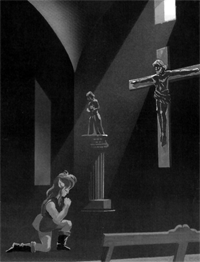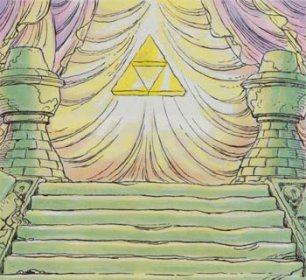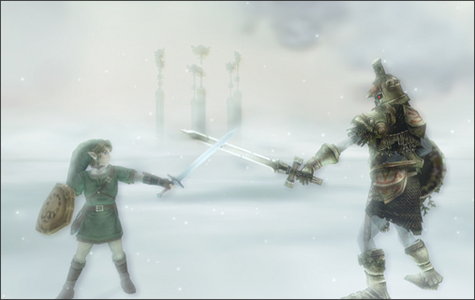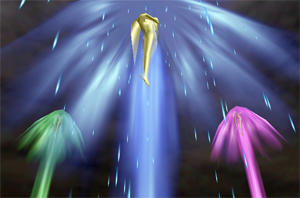The Legend of Zelda and Religion
Posted on January 21 2011 by Legacy Staff
 This is an attempt to explore religion as it is practiced in Hyrule and surrounding territories and how real-world religious symbolism has influenced the Legend of Zelda series.
This is an attempt to explore religion as it is practiced in Hyrule and surrounding territories and how real-world religious symbolism has influenced the Legend of Zelda series.
Creepy Cool Crosses – The Classic Era
The four-armed cross is a symbol for many cultures and traditions, but in modern times the cross is taken around the world as “the symbol for Christianity.” Rumor has it that before the creation of the third game (which described the mythology of the Three Goddesses for the first time – in the manual) the Nintendo team had planned to use Christianity as Hyrule’s dominant religion. If so, it would be fitting for the “Medieval Europe” feel of the games.
The original Legend of Zelda for the NES and its sequel, The Adventure of Link, featured crosses in abundance. In addition to the cemeteries, where graves bore this mark, Link carried a shield with a cross emblazoned on it and, in AoL, a cross was a magic item that allowed the player to see invisible ghosts.
No doubt, however, if they had continued on that route, it would have felt like “They’re getting fantasy in my religion!” for some and “They’re getting religion in my fantasy!” for others – something that has polarized fans of various anime and Japanese-authored video games since those things have become popular worldwide. In media that uses a real-world religion as its mythology but fails to stay accurate to the source, there is great potential to alienate fans either because their religion is being portrayed with gross inaccuracies or because they want nothing to do with a religion practiced in the real world when they are trying to enjoy a fantasy.
This, perhaps, is why Nintendo of America decided to censor certain references in the original games early-on for the sake of the American audience. The classic Legend of Zelda, for example, features a “Spell Book” that allows you to cast fire when the Magic Wand item is used. In the original Japanese version of the game, this “Spell Book” was the “Bible.” The use of the Christian holy book as a spell casting device would likely have alienated Christian players – or more accurately, their parents. “Magic” is seen as harmful by many Christian denominations, particularly the more conservative churches, case in point being the controversy in America over whether or not Christian parents should allow their children to read the Harry Potter book series. Even 1980s-1990s era Christian parents who were accepting of magic in works of fiction may have drawn the line at a Bible used as a spell book. While it was likely that no offense to Western culture was meant by it (it does seem innocent enough), the implications would not have come across well in the culture the game was being exported to at the time.
This is precisely why I am glad that Nintendo decided to craft the Goddess-mythology for the series ever afterward. Fantasy worlds that draw upon the symbolism of many world religions and mythologies while crafting their own distinct mythology do well to draw the reader/viewer/player into another world.
Triforce and Trinity
One of the most significant symbols in The Legend of Zelda mythos – if not the most important symbol – is the Triforce. It began as an artifact embodying particular virtues. The three-part Triforce-design is based upon a symbol of significance to Japanese history, the crest of the powerful Hojo clan. It took upon particularly important meaning in the Zelda-verse mythology when it became tied to the Three Goddesses.
 The Triforce’s roots (as well as the possible roots of the three sacred jewels, pendants and pearls seen throughout the game series) would seem to lie in Shinto, which can be read about in greater detail in the article here. The linked article deals with Shinto elements in A Link to the Past in particular.
The Triforce’s roots (as well as the possible roots of the three sacred jewels, pendants and pearls seen throughout the game series) would seem to lie in Shinto, which can be read about in greater detail in the article here. The linked article deals with Shinto elements in A Link to the Past in particular.
A cursory look into Japanese mythology speaks of the three regalia symbolizing the Japanese royal family (one of which is a sword interestingly nicknamed “Grasscutter” or “Lawnmower” depending upon translation – something to ponder when you’re using Link’s Master Sword to cut the grass). The regalia are meant to represent the virtues to be embodied by the descendants of the sun goddess, Amatersu – the royal family. These virtues are “wisdom,” “benevolence,” and “valor,” or “power,” “wisdom” and “benevolence/courage,” depending upon translation. It is very easy to see the links between these stories and the Legend of Zelda universe.
(It is to be pointed out that in the first The Legend of Zelda there were only two Triforces – representing how the Hero had to first gain wisdom before he could topple/gain power. Being the “Triforce” a third one may have been in mind from the beginning – perhaps with Link himself representing its virtue (courage). The third Triforce showed up in the second game, The Adventure of Link, after which the heavy Christian / crosses symbolism of the games was edged away in favor of the mythology of the Three Goddesses).
“Threes” and three-part symbols are significant to a number of other religions and mythologies, as well. From the Hecate Sisters (Maiden, Mother and Crone), to significant symbolism in both ancient mythologies and modern Wicca, to the Great Trinity of Brahma, Vishnu and Shiva in Hinduism, to the Holy Trinity of Christianity, “three” and “the three-in-one” have great significance for various spiritual traditions.
The Holy Trinity of Christianity, in particular, is a difficult concept to explain or even grasp, even for its followers. It is the doctrine is that the Supreme Being, God, conveys him/itself to mankind in three forms: The Father (Creator), the Son (Jesus, God-incarnate-as-human), and the Holy Spirit (Spirit) and yet, at the same time, is One. Many Legend of Zelda fans who happen to be Christians will point to the Triforce as being representative of a similar basic concept – three virtues embodied in one.
In the Legend of Zelda universe, however, we know that the Triforce represents the virtues of Power, Wisdom and Courage, embodied in an artifact of one whole that serves as the providence of the Three Goddesses. I do not say that it is anything more or less than that, only that world religions have had similar concepts, which perhaps shows an attention to general mythology on the part of Nintendo and makes the games’ world relatable for people of different backgrounds.
Animism, Shinto, Spirits
Shinto is the native religion of Japan. It is a philosophy of life, a way of bridging the gap between the present and the past and a way of connection to the natural and spiritual worlds. Its influence on the spiritual world of the Legend of Zelda games, as discussed with the Triforce above, is easy to see. Its practitioners hold that everything has a spirit (in Japanese, kami). Various things in nature are revered as having especially powerful spirits – such as particular mountains and sacred trees.
When once considers the various spirits and minor deities present in the various Legend of Zelda games – from the Light Sprits of Twilight Princess to the Great Deku Tree of Ocarina of Time, to even the Poes (spirits not necessarily of the dead, but born whole-cloth out of the pain and hatred of the land), one might consider a Shinto influence common to many stories of Japanese media.

Afterlife – and No Rest for the Heroes
The Legend of Zelda games would appear to be quite vague on the Afterlife. There definitely seems to be one in one form or another as ghosts are prevalent. The various Links meet many ghosts in their journeys, from the Poes they kill (or bottle) – to the dead heroes of Termina that the Hero of Time must heal in Majora’s Mask, to the spirit of an ancestor who must show the Hero of Twilight Princess various battle techniques in order to move on.
Just where the dead move on to is left a mystery. Whether it is to a Heaven to be with the Goddesses (which might resemble Christian mythology), or a “oneness with the universe” which may resemble Buddhism’s Nirvana, or to some kind of peaceful nothingness of “eternal sleep,” we really do not know. All we do know is that the aching spirits of Hyrule (and Termina) do seem eager to get there.
There are some hints to a “Heaven”-like afterlife. In Oracle of Ages, the spirit that Link helps in the Yoll Graveyard tells him that he hopes he will come to the Afterlife soon so he can play with the young Hero again before he vanishes. (The ghost hopes you will die soon. How…nice…). In Ocarina of Time, after defeating Twinrova, Koume and Kotake’s spirits treat us to one of the funniest scenes in all of the series as they bicker over their deaths and respective ages. Despite being evil, they receive halos over their heads and are taken up in a shaft of light. While a famous non-canon fan-comic by Hail Neko-Yasha explains this with “community service” , this may hint that Hyrule, in fact, has something of a Universalist afterlife – the good and the wicked essentially all get reconciled to the Goddesses and or come to a place of peace at the end.
Except for Ganondorf, who is powerful and evil enough to require sealing in a cosmic prison.
Then there is the idea of reincarnation. Reincarnation is a staple of various religions, the most well-known being Buddhism and Hinduism. Many Legend of Zelda fans hold that reincarnation is in full-force in the Zelda universe, particularly with the persons of Link and Zelda (if not Ganondorf – it is debatable whether his return for various games constitutes reincarnation or more of a straight resurrection). This is controversial within the Zelda fandom as some suggest that all of the Links and Zeldas are completely different people – perhaps relatives/descendants of each other and that’s it. Those that hold that Link and Zelda are old souls, reincarnated to fight Evil whenever it rears its ugly, pig-snouted head can hold to some real-world ideas about the subject. Perhaps Link and Zelda have not yet become fully enlightened and thus are unable to escape the cycle of rebirth?
Skepticism in Hyrule
I once brought up this subject in a casual thread-conversation on the Zelda Dungeon forum. I was met with an assertation of another ZD member that skepticism in Hyrule would never work because to have skeptical characters in a world where we “know what is true” would be insulting to real-life skeptics.
I beg to differ.
 “Flat Earth Atheism” is a literary trope denoting a character that lives in a world that we would call magical who, nevertheless, denies the existence or worship of gods. While some people dislike such characters, I have seen them handled in fiction in ways I thought went very well – after all, not believing in or bowing to gods doesn’t mean you cannot believe in or even use magic. As I see it, a person born and raised in Hyrule would see the things we see as “magical” as “mundane.” Fairies might be considered just another life-form. Magical artifacts might be considered the same way we consider weapons or machines of particular power. When something extraordinary is ordinary, it becomes, well…ordinary. Many things in our own world that we explain through science were once the domain of magic and mystery. Many people put a lot of trust in science to someday explain things that we currently see as mysterious. It doesn’t necessarily diminish beauty or wonder – one can look in awe at a sunset while knowing about the turn of the earth in relation to a giant ball of space-gas – one just knows the cause of that particular “miracle.” Knowing the details about it does not diminish the emotions and wonder felt.
“Flat Earth Atheism” is a literary trope denoting a character that lives in a world that we would call magical who, nevertheless, denies the existence or worship of gods. While some people dislike such characters, I have seen them handled in fiction in ways I thought went very well – after all, not believing in or bowing to gods doesn’t mean you cannot believe in or even use magic. As I see it, a person born and raised in Hyrule would see the things we see as “magical” as “mundane.” Fairies might be considered just another life-form. Magical artifacts might be considered the same way we consider weapons or machines of particular power. When something extraordinary is ordinary, it becomes, well…ordinary. Many things in our own world that we explain through science were once the domain of magic and mystery. Many people put a lot of trust in science to someday explain things that we currently see as mysterious. It doesn’t necessarily diminish beauty or wonder – one can look in awe at a sunset while knowing about the turn of the earth in relation to a giant ball of space-gas – one just knows the cause of that particular “miracle.” Knowing the details about it does not diminish the emotions and wonder felt.
Furthermore, the creation legend of Hyrule (as seen in the Great Deku Tree’s story in Ocarina of Time) would seem to paint the Three Goddesses in a somewhat Deist light. They created the world and then flew back to their distant nebula. It would seem that they involve themselves in the lives of mortals seldom, if at all. It would be easy for the average Hyrulean to become skeptical of their care and their relevance – perhaps to the point of not believing in them at all. As shown above, the presence of magic would make no difference, as it can be seen as “just another part of nature.”
Some skepticism may exist in the Zelda universe already. In Ocarina of Time, there is a man in Castle Town you can speak to as Young Link. The man tells you that legend has it that Hylians have long ears “so that they can hear the voices of the gods,” but that he hasn’t heard anything! That random man would seem to be less whole-hearted believer and more of a skeptic, at least when it comes to the gods’ direct involvement in people’s lives. In addition, Link is often asked by people (Zelda and Sheik) “IF you believe the prophecy…” It is not taken for granted that he would, though playing as Link, you have to act like you do to further your way in the game at those points.
Other Considerations
I don’t think I can write an article about Hyrule and religion without mentioning the snafu with Ocarina of Time’s early liberal use of Muslim imagery. Most people who’ve been in the fandom for a while can point to how the symbol for the Gerudo people used to be a Crescent and star, similar to the symbol for Islam and was changed for future releases of the game – and how the music in the Fire Temple had to be changed subsequently because it contained an Islamic chant. I do not know the extent of the unintentional sacrilege in the use of those symbols, but Nintendo was wise to change things – especially seeing how having a Muslim symbol associated with the people that the arch-villain of the series came from presents unfortunate implications, never mind that the Gerudo people themselves would appear to be fantasy-pagan (with their own Goddess of Sands in the Spirit Temple). Much like the “Bible” being used as a spell book in first game, it probably was an innocent mistake, but one that had to be rectified in the interest of not skirting too close to the real world for audiences that would find it uncomfortable.
All in all, The Legend of Zelda series presents a rich tapestry of many concepts gleaned from many world mythologies and, perhaps, is something that people of all belief-systems or none at all can relate to and enjoy.
Note: Due to the nature of this article, comments will be heavily moderated. When commenting, please keep in mind the subject matter of the article and refrain from making generalized statements about which religion or religions you believe to be correct or incorrect, or about the impact of religion on society as a whole. This article specifically concerns elements of world religions in Zelda games, and the comments below are expected to reflect that.



